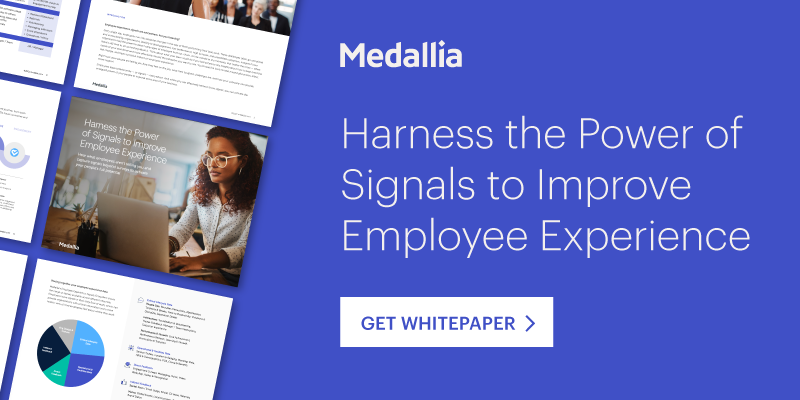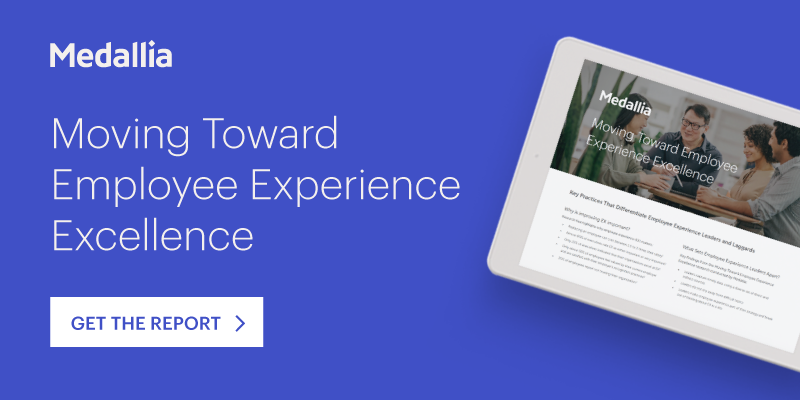Developing a great employee experience as part of a positive company culture is more important than ever. While the employee experience (EX) has been at the top of the list for HR leaders for several years now, fostering employee engagement is essential for an organization that wants to retain workers in today’s environment.
When employees are engaged in their work, they tend to stay longer at their jobs. Research shows that highly engaged teams have 21% to 28% reduction in employee turnover and 20% to 28% higher likelihood of high performance.
It takes a strong company culture and a focus on employee satisfaction to build and keep teams engaged. Eight in ten HR leaders say that feedback and check-ins are the keys to successful outcomes and engagement. The most productive companies start that process during recruiting and follow-through during onboarding to set the tone from the start.
What is employee onboarding?
Employee onboarding is providing employees with training, resources, and tools to quickly and efficiently get them acclimated to their new role. Typically, the employee onboarding process covers company culture and expectations in addition to information specific to the role.
Integrating and improving the employee onboarding process jumpstarts a positive experience by helping employees feel welcomed and confident in their new position. In this article, we’re going to discuss the onboarding process and the onboarding feedback questions you should ask as part of your employee experience strategy.
Onboarding feedback questions
A big part of creating a positive employee experience comes from regularly taking the temperature of your employees. Effective onboarding is critical to employee retention making it a valuable tool for influencing employee engagement early on. Onboarding feedback questions are a great way to get an immediate read on how employees are feeling about joining your organization. Onboarding surveys can also catch early warning signs of employees disengaging or detect changes in attitudes. This gives you an opportunity to address these issues before they become larger organizational problems.
Employee onboarding feedback questions can have many variations. Some companies ask open-ended questions while others ask employees to rate their thoughts on a 5-point scale. Then, they compare answers at key intervals. The type of questions you ask (open-ended vs. ratings) is less important than what they reveal and how employee attitudes change over time.
Sample onboarding feedback questions
Open-ended feedback questions
Here are a few sample questions you may want to include if you are asking open-ended questions:
- Do you have a clear understanding of what your job entails?
- How does your role match up with what you were told during the recruitment process?
- Do you have the resources and tools you need to do your job well?
- What challenges have you faced so far?
- Did you receive adequate training to do your job?
- Is there anything we need to improve in our recruiting or onboarding process? If so, what would you change?
- Are there any specific tools or resources you feel are missing or could enhance your performance in your current role?
- Reflecting on your onboarding experience, what aspects of the process were particularly helpful, and what areas do you think could be improved for new hires in the future?
Feedback on the onboarding process
You may also want to ask employees to evaluate the onboarding process and the company culture on a scale of 1 to 5. Sample onboarding survey questions might ask employees to provide a rating for these questions:
- This job meets the expectations set during recruiting. (1–5)
- Prior to starting my new job, I felt welcomed by my new team or manager. (1–5)
- I have access to the technology I need for my job. (1–5)
- My manager has been supporting my transition into the organization. (1–5)
- I feel like I belong here at [company]. (1–5)
- The training provided by the company has effectively prepared me for my role. (1–5)
- I have a clear understanding of the company’s mission and values. (1–5)
- My colleagues are approachable and willing to help me when I have questions or need assistance. (1–5)
- The company’s communication about its expectations and goals is clear and consistent. (1–5)
- I have had the opportunity to engage in meaningful work and contribute to the company’s success since starting my job. (1–5)
Feedback on the company by new hires
You might ask employees to rate these statements as part of your new-hire survey:
- My job duties are clearly defined. (1–5)
- I see a career path and an opportunity for promotion. (1–5)
- I have the tools and resources I need to do my job. (1–5)
- My boss is supportive. (1–5)
- My boss cares about me. (1–5)
- The onboarding process helped prepare me for this job. (1–5)
- The job matches the expectations I had during the recruiting process. (1–5)
- I would highly recommend this company as a great place to work to my friends and colleagues. (1–5)
- The company’s values align with my personal values and priorities. (1–5)
- My colleagues collaborate effectively, and teamwork is encouraged. (1–5)
- The company culture promotes work-life balance and well-being. (1–5)

Fun onboarding questions for new hires
- Two Truths and a Lie: Have new hires share two true facts about themselves and one false fact. This can be a fun icebreaker, and it’s a great way for team members to get to know each other.
- Purpose: This question promotes bonding, encourages authenticity, and helps break the ice.
- The Superpower Question: Ask new hires if they could have any superpower, what it would be and why. This is a playful way to get to know their aspirations and personalities.
- Purpose: Understand their aspirations, creativity, and what motivates them.
- Dream Desk Setup: Have new hires describe their dream desk setup, including gadgets, decorations, and anything else they’d like. It’s a fun way to understand their preferences and personalities.
- Purpose: Learn about their workstyle and how to create a comfortable work environment.
- Favorite Work Playlist: Ask new hires to share their go-to songs or playlists for work. You can create a team playlist with their suggestions.
- Purpose: Create a shared experience, and get insights into their music preferences.
- Movie or Book Character: If they could be any fictional character for a day, who would they choose and why?
- Purpose: Understand their interests, values, and imagination.
- Desk Plant Personality: If they were a desk plant, what kind of plant would they be and why? This can lead to fun discussions about growth, care, and resilience.
- Purpose: Encourage creativity and self-reflection.
- Bucket List Item: Ask new hires to share one item from their bucket list that they hope to achieve in the future.
- Purpose: Understand their goals and aspirations outside of work.
- Inspirational Quote: Ask them to share an inspirational quote that motivates them in their personal or professional life.
- Purpose: Gain insight into their values and sources of motivation.
- Future Predictions: Ask them to make a prediction about a future trend or development in their field.
- Purpose: Encourage forward thinking and creativity.
- Feedback Wishlist: In one sentence, ask them what they hope to gain from the onboarding experience.
- Purpose: Collect valuable feedback to improve the onboarding process.
Listen to signals that go beyond employee feedback surveys
Gathering employee feedback through surveys is just one step towards successfully improving your greater onboarding process. Oftentimes, the most invaluable information lies between the lines of the answers already provided to you through feedback methods, such as surveys. Begin fine-tuning your ability to understand signals in order to get the most from your feedback.
Employee experience signals are indicators about how an employee feels towards your company, offered through a collection of direct and indirect behaviors. Common signals that might speak volumes about an employee’s experience with your company include:
- Service tickets
- Slack or email usage
- Benefits usage
- Meeting attendance
- PTO or sick time patterns
- Manager/team changes
Be sure to implement a listening strategy for signals to begin collecting invaluable data for improving the employee experience.
Align employee onboarding feedback questions with company goals
The feedback you get from employee onboarding surveys is extremely valuable. It helps you gauge how effective your onboarding process is and whether it is meeting employee expectations. More importantly, it helps you see gaps in your onboarding process.
Not only does this help evaluate your processes, but it helps you pinpoint any problems employees are having. For example, if they say they do not have the resources they need to do the job, it allows you to delve deeper to see if that is accurate or a misperception. You may discover they have what they need, but need additional training. Either way, you want to find out this kind of information sooner rather than later.
Employee onboarding feedback questions also help you ensure that an employee understands your organization’s goals and how they fit into the bigger picture. This alignment is crucial to maximizing employee productivity.
Regardless of which employee onboarding feedback questions you ask, you should aim to uncover the keys to employee engagement:
1. Commitment to organizational goals
2. Identification with company mission
3. Job satisfaction
4. Feeling energized at work
When employees score strongly in these areas, engagement increases. It is especially important for new hires to understand the role they play in fulfilling organizational goals and objectives.

Discover room for improvement with employee onboarding
According to Forbes, most companies have plenty of room for improvement with their employee onboarding process. 81% of new employees feel overwhelmed with the onboarding process and 72% of employees think that they might be asking too many questions. It’s hard to make the employee experience better without this understanding.
Help employees stay connected
Onboarding surveys help employees feel connected, but only if they feel like someone is listening to their feedback and acting on it. When you identify a problem an employee is having and solve it promptly, they feel valued.
Onboarding surveys can also catch early warning signs of employees disengaging or detect changes in attitudes. This gives you an opportunity to address these issues before they become larger organizational problems.
It’s important to survey employees early and often. Sending surveys is not limited to right after an employee joins the organization. In fact, it’s a good idea to do employee surveys at regular intervals, such as at the end of the first, third, and sixth months to see how perceptions have changed. Workers may feel differently about a job or organization after six months of working their position.
Most importantly, however, is that you build a formal plan to help enhance the employee experience within your organization. Employee onboarding surveys can help you better understand what’s happening in your organization, but it’s what you do with the information that counts.
To learn more about improving the employee experience at your organization, read our e-book, The Definitive Guide to Employee Experience.









